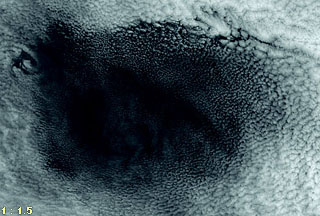
"Convective Cells"
"Black Holel" Phenomenon (BHP)
 The
absence of cloudiness within Convective Close Cells structures was tentatively
defined as a "Cloud Black Hole" phenomenon. The
absence of cloudiness within Convective Close Cells structures was tentatively
defined as a "Cloud Black Hole" phenomenon.
Such cloudlessness may be explained by anticyclone developments (which
is proved by the near surface wind direction around the "black hole").
Such phenomenon may occur in the area above masses of cold water where
cold dry air rushes out from the upper layers of the atmosphere, driving
away the cloud cells in its way.
The holes are usually round or oval, but their shape is often irregular,
"lacerated".
This phenomenon mainly emerges within low small-cells convective cells
structures in the circumpolar regions above water surface, mostly above
the waters situated close to the Antarctic.
The edges of black holes usually make up small closed convective cells,
nearly dissolved in the air.
The holes may be several dozens of kilometers in size or much larger -
up to several hundreds of km.
Cloud black holes do not emerge often in the atmosphere.
|